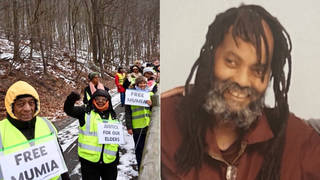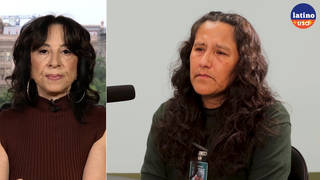
Guests
- Clarence Moses-ELjust released from prison on Tuesday after serving 28 years for a crime he has always maintained he did not commit. In 1989, he was sentenced to 48 years in prison after a woman said she dreamed he was the man who raped and beat her in the dark.
- Eric Kleinone of the defense attorneys for Clarence Moses-EL.
Clarence Moses-EL has walked free after 28 years behind bars for a crime he says he didn’t commit. In 1989, Moses-EL, who is African-American, was sentenced to 48 years in prison after a woman said she dreamed he was the man who raped and beat her in the dark. Moses-EL has always maintained his innocence. The police threw out a rape kit and any possible evidence, like bed sheets and her clothes. Then in 2012, another man confessed to the attack. But Moses-EL remained behind bars until this week, after his conviction was overturned. In a Democracy Now! exclusive, Clarence Moses-EL joins us to discuss his newfound freedom and how another person’s dream became his nearly three-decade nightmare.
Transcript
AMY GOODMAN: This is Democracy Now!, democracynow.org, The War and Peace Report. I’m Amy Goodman, as we turn to a story of how one woman’s dream became another man’s nightmare, and after nearly three decades, that nightmare may finally over. Clarence Moses-EL was released from prison in Denver this week after serving 28 years for a crime he has always maintained he did not commit. In 1989, Moses-EL, who is African-American, was sentenced to 48 years in prison after a woman said she dreamed he was the man who raped and beat her in the dark. The victim was raped and badly beaten in her apartment. Initially, she named three men she had been drinking with that night as her possible attackers—none of them was Clarence Moses-EL.
Police never investigated the other men, because a day and a half later, the victim said she had a dream that Moses-EL was the one who raped her. The police threw out a rape kit and any possible evidence, like bed sheets and her clothes. In 1995, after years in prison, Moses-EL had won a court order mandating the forensic analysis of the evidence, which could have freed him. He managed to raise $1,000 from fellow inmates to pay for the tests. The judge instructed the Denver police to turn over the evidence. The police marked the evidence box “DO NOT DESTROY,” and then, inexplicably, threw it into a dumpster.
Clarence Moses-EL languished in prison until, in 2012, he received a handwritten letter from another Colorado prisoner, L.C. Jackson. He was one of the three men initially named as a suspect by the rape victim, until she gave Moses-EL’s name following her dream. Jackson wrote to Moses-EL, “I really don’t know what to say to you. But let’s start by bringing what was done in the dark into the light. I have a lot on my heart. I don’t know who['s] working on this. But have them come up and see me. It's time. I’ll be waiting,” he wrote. Denver District Attorney Mitch Morrissey sat on Jackson’s confession for close to two years. Moses-EL and his legal team were eventually able to obtain a court hearing to introduce Jackson’s confession and other new evidence. Finally, earlier this month, a Colorado judge vacated Moses-EL’s convictions, ordering the DA to either retry the case or drop the charges.
On Tuesday afternoon, Clarence Moses-EL was released to a crowd that included his wife, his son, several of his 12 grandchildren—whom he had never met, as he did not want them to see him in prison. Clarence Moses-EL briefly addressed reporters about his newfound freedom.
CLARENCE MOSES-EL: This is the moment of my life right here. I just feel really great. I mean, I’m kind of lost for words, but I feel really great. … My spirituality, that’s what really kept me going, and my innocence. That that’s what I have—I can say right now, that’s what really kept me going.
AMY GOODMAN: To the shock of many, prosecutors say they’re going to retry Moses-EL, with a tentative trial date set for later next year. The judge in the case has said Moses-EL would likely be acquitted if he’s forced to stand trial again.
Well, just two days after he’s walked out of prison a free man, Clarence Moses-EL joins us now. We’re also joined by one of his attorneys, Eric Klein.
We welcome you both to Democracy Now! Clarence Moses-EL, how does it feel to be free after 28 years?
CLARENCE MOSES-EL: It’s amazing to be here today, as well as just being free. It feels almost surreal. I’m kind of lost for words at this moment to speak about how good it feels. But it feels tremendous. I mean, I’ve never felt like this in all my life, basically, realistically. It’s a feeling that, you know, takes a whole lot of things to really explain it, and at this time, I really—I’m just so overwhelmed, I just really don’t have all the words to explain how good I feel.
AMY GOODMAN: When you got out of prison, you saw some of your grandchildren for the very first time. How did that feel?
CLARENCE MOSES-EL: I was overwhelmed. And the reason why, because when I was arrested for this case in 1987, my youngest grandson, that I believe the camera showed him the other day when I came out, Arell [phon.], that was the size and age of my son Anthony. He was three, going on four. So, to see my grandchildren, it was just overwhelming to know that my son had grown up into an adult, and now he have children. And to see those children, it was—it was just mind-boggling. I felt good about it, but it was just mind-boggling, because I couldn’t really believe it, that I got grandkids.
AMY GOODMAN: Now, in 1995, you were in jail for years, like six years or more than that. You were able to muster the money from fellow inmates, $1,000, to be able to test the forensic evidence—the rape kit, the sheets, the victim’s clothes. When you got the letter in jail, that—although that box of evidence was located, it was labeled “DO NOT DESTROY,” the police then put it into the dumpster, so you were never able to get that evidence tested. What—how were you told of this, and what was your reaction?
CLARENCE MOSES-EL: Well, I was told by one of the attorneys that was representing me at that time, because I had anticipated the evidence being tested by Barry Scheck, who is the founder of the Innocence Project, and at that time the Innocence Project was located in New York, and I really felt and believed that this was my opportunity, especially with Barry Scheck stepping in, that the evidence was going to be tested, and it was going to prove my innocence. And when I found out that the evidence had been destroyed, you know, I went into a deep, deep, dark state of being depressed, lost for hope. I felt really bad at that time. I said, “Man, I know this can’t be real,” after all of this that I went through, campaigning, asking friends of mine, who believed in me, because at no time did I ever waver about this story, trying to get people to hear me, even my fellow inmates. I was free at expressing what I was in there for and my desire to prove my innocence. And so, there was various inmates that came to my support, you know, donating $25, $50, $100. They believed in me. So I believed in myself. And I said, “Well, if I could get this money and send it to Barry Scheck, I said, man, I could get my—this evidence tested, and I’ll be able to get out of here.” But after they told me that the evidence was destroyed, I mean, it devastated me. I felt like I had done hit rock bottom.
AMY GOODMAN: Then, years later, in 2012, you get a letter from L.C. Jackson, who says he wants to confess. What was your reaction at that time to receive this letter, as he said he wanted to come out of the dark into the light?
CLARENCE MOSES-EL: At the time when I received that letter, I was playing this card game called spades. And a friend of mine walked to me and said, “Here’s a letter.” And I looked at the letter, and I seen whose name was on it. And I asked myself, I said, “Well, why is he writing me?” because I really didn’t know. It was a surprise to me. And I started reading the letter. And once I started reading the contents of the letter, I jumped for joy. I got to running around. I said, “Man,” I said, “This guy, he’s coming through.” I said, “Man, I’m going to be getting out of prison.” I just felt so jubilant. I was full of joy. You know, like I said, I ran around. I ran around the pod saying, “OK, my time has come. I’m getting out of here. The person that did it done finally came forth and confessed to it.”
AMY GOODMAN: Well, that was after a quarter of a century of you being in prison. We’re going to break. When we come back, I want to ask your lawyer, Eric Klein, how it’s possible that even that letter, which was more than two years ago, did not lead to your immediate release, and what the judge’s decision was in the last few weeks and where you head from here. We have an exclusive interview today with Clarence Moses-EL, who is just out of prison this week after 28 years in jail for a crime he says he did not commit. Stay with us.
[break]
AMY GOODMAN: How one woman’s dream became a man’s 30-year nightmare. We’re talking about the case of Clarence Moses-EL, who was convicted on the basis of a woman’s dream that he was the one who raped her, although the day before she had named three other suspects who she had been drinking with that night. In 2012, one of those men that she originally named wrote Clarence Moses-EL a letter in prison, saying he wanted to come forward. But that was more than two years ago. Clarence Moses-EL joins us in this exclusive interview. As we broadcast this show today, he is in Denver. And Eric Klein joins us, his defense attorney.
Eric Klein, can you talk about 1995, when the evidence the police gathered and kept for years, after Clarence Moses-EL requested it and a judge approved the request, was destroyed, actually put into a dumpster, with the wording on the box “DO NOT DESTROY,” and then, why in 2012, when L.C. Jackson wrote Clarence Moses-EL this confession letter, it took more than two years for Clarence Moses-EL to get out of jail, for a judge to vacate his conviction?
ERIC KLEIN: Well, Amy, one of the real tragedies here is that Mr. Moses-EL should have been freed more than 20 years ago. A DNA evidence, there was evidence present that would have definitively identified the true perpetrator here. And Mr. Moses-EL had that opportunity. The District Attorney’s Office should have been interested in that, as well, and could have tested it themselves at that point. And I think that today the Denver District Attorney’s Office really needs to ask itself, why would Mr. Moses-EL seek to conclusively identify the true perpetrator of this offense, unless he’s absolutely innocent? And it’s a horrible tragedy that—what happened to the victim in this case, and it’s a tragedy that’s compounded by the fact that the wrong man was prosecuted and was incarcerated for all this time.
And then, come to 2012, when Mr. Jackson came forward, at that time, Mr. Moses-EL’s attorney who was on the case investigated, spoke to Mr. Jackson. He admitted his involvement. In 2013, a motion was filed on Mr. Moses-EL’s behalf to obtain a new trial. And that’s what the law would allow, for a judge to order a new trial. The District Attorney’s Office opposed that, and actually opposed even allowing Mr. Moses-EL an evidentiary hearing on this claim and on Mr. Jackson’s admissions.
This summer—so a judge denied—or, granted Mr. Moses-EL a hearing, and that hearing was held this summer. At that time, the judge heard from L.C. Jackson, heard from Mr. Jackson’s girlfriend at the time in 1987 who he was living with and who was a neighbor of the victim and who testified that Mr. Jackson was gone from her home during the crucial period of time when the victim was attacked. The judge also heard from an expert forensic biologist, because we were able to obtain a saliva sample from L.C. Jackson, and the forensic biologist was able to determine, based on the blood typing that was done back in 1987, even though DNA testing wasn’t done, that Mr. Jackson’s blood type was consistent with the evidence in this case and that there’s a far greater likelihood that the perpetrator was somebody of that blood type than somebody of Mr. Moses-EL’s blood type, and Mr. Moses-EL’s blood type is absolutely inconsistent with the evidence in this case.
AMY GOODMAN: I mean, what’s astounding right now is that the judge gave the option of retry or drop the charges. Mitchell Morrissey, the Denver DA, has gone after Clarence Moses-EL for years. Now, he will be retiring. He will not be running again. Two of the candidates for Denver DA have said they would drop the charges. Why aren’t these charges being dropped right now? Why does Clarence Moses-EL, who just got out of jail after over 28 years, still live with this possible trial over his head?
ERIC KLEIN: That’s an excellent question, Amy, and it’s a question we hope will be answered soon. The Denver DA has said that they have not yet made a decision, and so we are hoping they will come to that decision soon and that the decision will be that there’s absolutely no point in retrying an innocent man. All of the evidence in this case points to somebody else, primarily L.C. Jackson, as the perpetrator and points absolutely away from Mr. Moses-EL. We’ve been very clear that we’re not saying that the victim fabricated her allegations against Mr. Moses-EL, but everything points to her naming him and her identifying him as the perpetrator as being a mistaken and erroneous identification. And erroneous identification is the number one cause of wrongful convictions in this country.
AMY GOODMAN: How could he have been convicted based on her dream?
ERIC KLEIN: It’s a great question. I’ll say that 12 jurors heard the evidence, heard her testimony in court.
AMY GOODMAN: Well—
ERIC KLEIN: I think that a lot has been—
AMY GOODMAN: I want to—we only have about a minute and a half, and I want to go back to Clarence Moses-EL. Clarence, can you tell us about your mother, who fought for you to be freed for many years?
CLARENCE MOSES-EL: My moms was a very strong advocate for me. And she always believed in me, just like I believed in myself. And she always told me to keep my faith, because eventually—although I had went through that hurdle of being convicted, she told me, “Son, one day, the truth is going to come out, and you’re going to be set free.” So she’s—before she passed away, she was a very strong force in my life. In fact, even after her death, she’s still a strong force in my life.
AMY GOODMAN: And, Clarence Moses-EL, as we wrap up, what do you plan to do with your freedom? What are your future plans?
CLARENCE MOSES-EL: My future plans, I would like to engage myself with giving back to the community. As far as—over the years being incarcerated, I watched TV, and I was looking at so many things happening in society that I just want to be a productive part of it. And helping the youth, basically just giving myself where I could be of help, where it’s necessary, this is my main interest.
AMY GOODMAN: And, Clarence—
CLARENCE MOSES-EL: Going back to—
AMY GOODMAN: Clarence, what kept you going all of these years in prison?
CLARENCE MOSES-EL: My faith and my innocence. Those two things is what really kept me going. And it caused me to recognize and identify with the strong will that’s in me. I couldn’t allow myself to accept being incarcerated, especially for something that I didn’t do. So, that moved me very strongly. It was my faith and my determination to prove my innocence. My innocence was the driving force, along with my will.
AMY GOODMAN: We have to leave it there. I want to thank you so much both for being with us, and a very happy holidays to you, Clarence Moses-EL. We’ll link to your Facebook page at Facebook.com/clarencemosesel.













Media Options